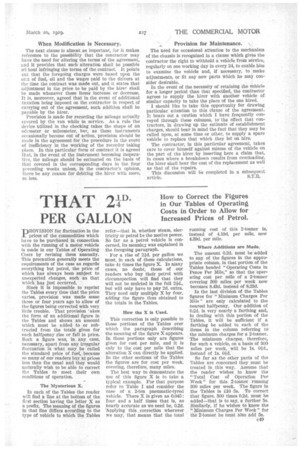THAT 21D .
Page 79

If you've noticed an error in this article please click here to report it so we can fix it.
PER GALLON
pROVISION for fluctuation in the r prices of the commodities which have to be purchased in connection with the running of a motor vehicle is made in our Tables of Operating Costs by revising them annually. This precaution generally meets the requirements of the case as regards everything but petrol, the price of which has always been subject to unexpected changes, such as that which has just occurred.
Since it is impossible to reprint the Tables every time that the price varies, provision was made some three or four years ago to allow of the figures being corrected with very little trouble. That provision 'akes the form of an additional figure in the Tables and shows an amount which must be added to or subtracted from the totals given for each halfpenny rise or fall in price. Such a figure was, in any case, necessary, apart from any irregular fluctuation in what may be called the standard price of fuel, because so many of our readers buy at prices less than the usual and they would naturally wish to be able to correct the Tables to meet their own conditions of operation.
The Mysterious X.
In each of the Tables the reader will find a line at the bottom of the first section having the letter X as a prefix. The meaning of the figures in that line differs according to the type of vehicle to which the Tables refer—that is, whether steam, electricity or petrol he the motive power. So far as a petrol vehicle is concerned, its meaning was explained in the foregoing paragraph.
For a rise of ald, per gallon we must, in each of these calculations, take 41 times the figure X. In many cases, no doubt, those of our readers who buy their petrol with circumspection will find that they will not be mulcted in the full but will only have to pay 2d. extra. They need only multiply X by four, adding the figure thus obtained to the totals in the Tables.
How the X is Used.
This correction is only possible to those portions of the Tables over which the paragraph describing the meaning of the figure X appears. In those portions only are figures given for cost per mile, and it is only to the cost per mile that the alteration X can directly be applied. In the other sections of the Tables the figures are for cost per week, covering, therefore, many miles.
The best way to demonstrate the use of this figure X is to take a typical example. For that purpose refer to Table I and consider the case of a 2-ton pneumatic-tyred vehicle. There X is given as 0.045: four and a half times that is, as nearly accurate as we need be, 0.2d. 'Applying this correction wherever we may, that means that the total
running cost of this 2-tonner is, instead of 4.19d. per mile, now 4.39d. per mile.
Where Additions are Made.
The amount 0.2d. must be added to any of the figures in the appropriate column, in that portion of the Tables headed "Operating Costs in Pence Per Mile," so that the operating cost per mile of a 2-tonner covering 300 miles per week now becomes 8.43d. instead of 8.23d.
In the last division of the Tables figures for "Minimum Charges Per Mile" are only calculated to the nearest halfpenny. Our addition of 0.2d. is very nearly a farthing and, in dealing with this portion of the Tables, it will be sufficient if a farthing be added to each of the items in the column referring t& the minimum charges for a 2-tonner. The minimum charges, therefore, for such a vehicle, on a basis of 300 miles per week, will be is. Old., Instead of is.
So far as the other parts of the Tables are concerned they must be treated in this way. Assume that the reader wishes to know the "Total Cost of Operation Per Week for this. 2-tonner • running 300 miles per week. The figure in the Tables is £10 5s. To correct that figure. 300 times 0.2d. must be added—that is to say, a further. 5s. Similarly, if he wishes to know the " Minimum Charges Per Week" for the 2-tonne r he must also add 5s.




























































































































